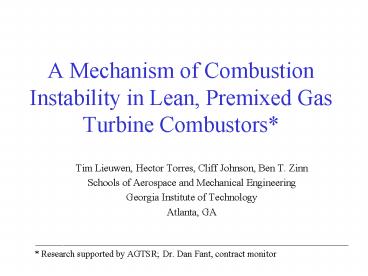A Mechanism of Combustion Instability in Lean, Premixed Gas Turbine Combustors* - PowerPoint PPT Presentation
1 / 28
Title:
A Mechanism of Combustion Instability in Lean, Premixed Gas Turbine Combustors*
Description:
A Mechanism of Combustion Instability in Lean, Premixed Gas Turbine Combustors* Tim Lieuwen, Hector Torres, Cliff Johnson, Ben T. Zinn Schools of Aerospace and ... – PowerPoint PPT presentation
Number of Views:423
Avg rating:3.0/5.0
Title: A Mechanism of Combustion Instability in Lean, Premixed Gas Turbine Combustors*
1
A Mechanism of Combustion Instability in Lean,
Premixed Gas Turbine Combustors
- Tim Lieuwen, Hector Torres, Cliff Johnson, Ben T.
Zinn - Schools of Aerospace and Mechanical Engineering
- Georgia Institute of Technology
- Atlanta, GA
- __________________________________________________
__________________ - Research supported by AGTSR Dr. Dan Fant,
contract monitor
2
Combustion Instabilities in Lean Premixed (LP)
Gas Turbines
- Combustion instabilities are an important problem
hindering the development of LP industrial gas
turbines - Flame Flashback or blowoff - constrains regions
of operability - Fatigue Cracking of Liners - reduces combustor
life - Development of approaches to suppress these
instabilities requires understanding the key
physical processes responsible for their
initiation.
3
Occurrence of Combustion Instabilities
- Combustion Instabilities occur when
- Energy Addition by Combustion Process (Rayleigh
Criterion) - Damping Mechanisms
- Radiation through boundaries
- Viscosity, heat conduction
Energy addition to the acoustic field by unsteady
combustion process
gt
Energy losses due to dissipation
dE/dt ltpqgt
4
Mechanisms of Combustion Instability
5
Identifying the Mechanism Responsible for
Instability Initiation
- A number of processes are simultaneously present
in combustors that cause heat release
fluctuations - Pulsations in fuel supply rate
- Pressure and/or velocity dependent burning rate
- Vortex shedding
- Changes in flame area
- Periodic changes in mixture composition
6
Flow and Reaction Processes in Gas Turbine
Combustors
Flame Stabilization
Fuel Inflow
Heat Losses
Convection
Swirling
Mixing
Flame and Flow Instabilities
Air Inflow
Exhausting
Chemical Reaction
7
Sensitivity of Lean Combustion Systems to
Disturbances in Mixture Composition
- Combustion process becomes very sensitive to
disturbances in composition under lean conditions
Characteristic Chemical time, s
Zukoski's Experimental Data
8
Sensitivity of Lean Combustion Systems to
Disturbances in Mixture Composition
- Combustion process becomes very sensitive to
disturbances in composition under lean conditions
0.0015
0.001
Characteristic Chemical Time, s
0.0005
0
0.5
0.7
0.9
1.1
1.3
1.5
1.7
1.9
Equivalence Ratio
Zukoski's Experimental Data
9
A Possible Mechanism for Combustion Instabilities
- Recent combustor stability models that capture
this mechanism - Lieuwen and Zinn, AIAA Paper 98-0641, 27th
Intl Symposium on Combustion - Peraccio and Proscia, ASME Paper 98-GT-269
10
Time evolution of disturbances responsible for
the onset of instability
11
Time evolution of disturbances responsible for
the onset of instability (continued)
- Combustion process adds energy to the acoustic
field when - (tci tpv tf tconvect teq)/T 1, 2, 3,
... - Simplifications
- Typical geometries tci/T 0
- Choked Fuel Injector tf/T1/2
- teq essentially an additional convective time
- discussed extensively in paper
12
Time evolution of disturbances responsible for
the onset of instability (continued)
- Combustion process adds energy to the acoustic
field when - (tpv tconvect)/T 1/2, 3/2,
- Implies that significant combustors parameters
are - Natural modes of combustor - T 1/f
- Inlet velocity - tconvect
- Fuel injector location - tconvect
- Upstream boundary condition of inlet - tpv
- Length of inlet - tpv
Linj/u
13
Dependence of Instability Region on Combustor
Configuration
Penn State Facility -
GT Facility -
DOE Facility -
- Conclusion For fixed geometry, instabilities can
occur when tconvect/T fLinj/u? constant - i.e., when uinletconstant x f
14
Combustor Section-Front View
Fuel
Hot Products
Air
15
Effect of Inlet Velocity on Instability Amplitude
and Frequency
- In both cases, peak amplitude occurs where
tconvect/T ?1.1-1.2
16
Effect of Inlet Velocity on Instability Frequency
uinlet36 m/s
uinlet18 m/s
uinlet25 m/s
17
Inter-dependence of Instability Frequency and
Inlet Velocity
18
Comparisons of Theory with Georgia Tech Data
(Rigid Upstream Boundary)
Conditions u10- 50 m/s f 0.65-0.9 p1-9 atm
19
Comparisons of Theory with Georgia Tech Data
(Rigid Upstream Boundary)
Theoretical Predictions
Conditions u10- 50 m/s f 0.65-0.9 p1-9 atm
20
Comparisons of Theory with DOE Data(Pressure
Release Upstream Boundary)
Theoretical Predictions
Conditions u30- 60 m/s f 0.6-0.8 p5-10 atm 3
Fuel injector locations
21
Comparisons of Theory with Penn State
Data(Anechoic Upstream Boundary)
Theoretical Predictions
Conditions Tin600-740 K f 0.4-0.7 p2.5-7
atm 3 Fuel injector locations
22
Conclusions
- Experimental observed stability limits consistent
with theoretical predictions - Suggests that instabilities are initiated by a
feedback loop between the combustion process,
combustor acoustics, and fluctuations in
reactants composition - Characteristic time analysis illustrates key
processes in this mechanism and suggests methods
for passive control
23
Supporting Slides
24
Characteristic Times Associated with Combustor
Processes
Acoustic Period 100 - 500 Hz Oscillations
Chemical Kinetics
Heat Loss, Diffusion
Convection
Mixing
Swirling Flow Turnover Time
25
Convective Processes in Gas Turbine Combustors
- Reactive mixture composition
- Flame Dynamics - Response of flame to flow
disturbances - Flow Instabilities - Distortion of flame by
convecting vortex structure
- tLinjector/u
- tLflame/u
- tLflame/u
26
Recent Measurements at U. Cal -Berkeley R.
Mongia, R. Dibble, J. Lovett, ASME Paper
98-GT-304
Combustor Pressure Spectrum
Methane Mole Fraction Spectrum
27
Results of a well-stirred reactor (WSR) model
- Unsteady WSR model subjected to perturbations in
the inlet f. - Response of the unsteady rate of reaction
increased as much as 200 times as f was decreased
from stoichiometric to lean mixtures - Conclusion f oscillations induce strong heat
release oscillations that can drive combustion
instabilities under lean conditions
From Lieuwen, T., Neumeier, Y., Zinn, B.T., Comb.
Sci. and Tech, Vol. 135, 1-6, 1998.
28
Phased Locked Images of Combustion Instability
- Line of sight (top half of picture) and Abel
inverted (bottom half of picture) images of CH
Chemiluminescence of 200 Hz. instability
Flow































